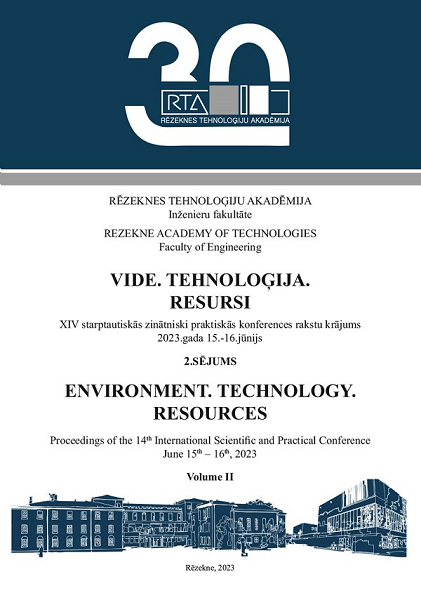FACTOR ANALYSIS OF WEB-BASED IDEA MANAGEMENT SYSTEM APPLICATION RESULTS
DOI:
https://doi.org/10.17770/etr2023vol2.7189Keywords:
Idea Management Systems, Web-based, Factor Analysis, ResultsAbstract
the aim of the study is to reveal the underlying factors from variable data collected on the results of the web-based ideas management systems related to management and tangible results in companies. The purpose of the factor analysis process is to collect the information contained in a large number of changes in such a way as to obtain latent factors with minimal data loss. Authors have conducted global survey for enterprises that apply these systems (n>500). The 8 variables that fit together reveal the latent factor “tangible” or tangible results and the remaining 6 variables that together reveal the latent factor “managerial” or the management results.
References
R. Adner, “Ecosystem as structure: An actionable construct for strategy”, Journal of Management, vol. 43, no.1, pp.39-58. 2017.
O. Granstrand and M. Holgersson, “Innovation ecosystems: A conceptual review and a new definition”, Technovation, 2020, pp.90-91, https://doi.org/ 102098.
H. Chesbrough and B. Marcel, “ Explicating open innovation: Clarifying an emerging paradigm for understanding innovation”, In Henry Chesbrough, Wim Vanhaverbeke and Joel West (Eds.), New Frontiers in Open Innovation, Oxford: Oxford University Press, 2014, pp.3-28.
M. Bagherzadeh, S. Markovic, J. Cheng, W. Vanhaverbeke, “How does outside-in open innovation influence innovation performance? Analyzing the mediating roles of knowledge sharing and innovation strategy”, IEEE Transactions on Engineering Management, vol. 67, no.3, pp.740-753, 2020.
A.K. Zobel, “Benefiting from open innovation: A multidimensional model of absorptive capacity”, Journal of Product Innovation Management, vol. 34, no. 3, pp.269-288, 2017.
T. Herrmann, D. Roth, H. Binz, “Framework Of An Ambidextrous Process Of Idea Management Supporting The Downstream Product Development Process”, Proceedings of the Design Society: DESIGN Conference, Editor D. Marjanović, M. Štorga, S. Škec, Martinec, vol.1, pp.587 – 596, 2020.
E. Mikelsone and E. Liela, “Discussion on the Terms of Idea Management and Idea Management Systems”, Journal of Regional Formation and Development Studies, vol. 3, no.17, pp. 97-110. 2015.
B.G. Tabachnick and L.S. Fidell, Using Multivariate Statistics, Third edition, HarperCollins College Publishers, 1996.
Maat et al., “Confirmatory factor analysis of the mathematics teachers' teaching practical instrument”, World Applied Sciences Journal Vol. 12, no. 11, pp. 2092-2096, 2011.
L. L. Chan, and N. Idris, “Validity and Reliability of The Instrument Using Exploratory Factor Analysis and Cronbach's alpha,” International Journal of Academic Research in Business and Social Sciences vol. 7, no.10, pp.400-411, 2017.
D. L. Strainer, “Starting at the Beginning: An Introduction to Coefficient Alpha and Internal Consistency”, Journal of Personality Assessment, pp. 99-103, 2003.
Vaske et al. “Rethinking Internal Consistency in Cronbach's Alpha”, Leisure Sciences, 2017, pp.163-173.
L. J. Cronbach, “Coefficient alpha and the internal structure of test”, Psychometrika, vol.16, pp. 297-334, 1951.
R. R. J. Glos, “Calculating, Interpreting, And Reporting Cronbach's Alpha Reliability Coefficient For Likert-Type Scales”, Midwest Research to Practice Conference in Adult, Continuing, and Community Education, pp.82-88, 2003.
C.O. Quandt, H.D.F.N. Silva, A.A. Ferraresi, J.R. Frega, “Idea management and innovation programs: practices of large companies in the south region of Brazil”, International Journal of Business Innovation and Research, vol. 18, no.2, pp.187–207, 2019.
B.P. Bailey and E. Horvitz, “What’s Your Idea? A Case Study of a Grassroots Innovation Pipeline within a Large Software Company”, In CHI2010 proceedings on the 28th annual CHI conference on human factors in computing systems, pp. 2065–2074, 2010, USA, Atlanta, NY: ACM. DOI: 10.1145/1753326.175364



